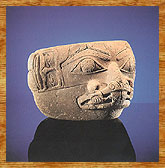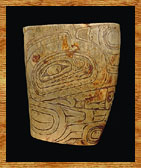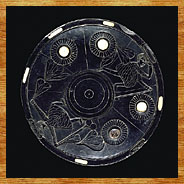(Page 2 of 3)
 |
The ability of Haida artists to work in stone is well documented in prehistoric carvings, particularly tobacco mortars and pestles. One interesting stone bowl, probably dating from the eighteenth century, depicts a Dragonfly carrying a human, possibly in reference to myths about Dragonflies transporting human souls. A later piece in argillite on the same theme portrays a human figure riding on the back of a Dragonfly.

 |
|
 |
A sandstone mortar for grinding burned clamshells to make lime, which was then mixed with flakes of dried native tobacco leaves; the lime chemically released the psychogenic compounds in the tobacco, much like the use of lime and betel nut in southeast Asia and other parts of the Pacific. The hands holding the stick that identify this as a Beaver emerge from the creature's own mouth, presumably to keep the sculpture very compact since more anatomically correct arms would easily break off.
Collected on Haida Gwaii in 1879 by Israel W. Powell.
CMC XII-B-318 (S91-946) |
|
A mortar of walrus ivory engraved with an image of the Raven holding a human being in its beak. Pieces of burned clamshell were crushed in this mortar to make lime for use with tobacco.
Collected at Masset before 1884 by James Deans for Dr. W. F. Tolmie of the Hudson's Bay Company.
CMC VII-B-1001 (S92-4292) |

The transition of argillite pipes from a ceremonial function to an item of exchange or sale is quite clear. By the 1830s, the sea otter trade that had brought the Haida so much wealth so quickly was over. However, as ships engaged in the trade for other furs continued to ply the coast, the Haida attempted to find substitutes for sea otter pelts by offering potatoes as well as fresh and dried fish. The sale of artworks also became increasingly important to the Haida economy. When the Hudson's Bay Company established a trading post at Fort Simpson on the mainland, British gunboats replaced maritime traders as customers to a large extent. Hundreds of pieces of carved argillite were purchased and taken home as souvenirs by sailors from New England, Britain and elsewhere.
When Reverend Jonathan Green stayed near Skidegate, he saw "pipes which the Haida make of a kind of slate stone are curiously wrought." Art historian Robin Wright has documented in detail the florescence of the panel pipe form, which lost its original funeral function and became a medium for the expression of myths and even for the recording of historical events.
Although panel pipes were the first form of argillite carving sold to tourists, the Haida soon began making and ornamenting other objects that appealed to Europeans. Dishes were particularly successful, since Victorians delighted in displaying plates, bowls and platters in cabinets, on sideboards and on special rails around their parlours. Pipes appealed enormously to seamen, while plates and platters were equally attractive to their sweethearts back home.

 |
An argillite dish made circa 1835 depicts European women apparently dancing, and it is also adorned with the leaves and berries of the native Haida tobacco plant. Rosettes and chrysanthemumlike motifs are also common in the work of this unnamed artist. Another plate by the same carver is in the Bristol Museum in England.
CMC VII-B-1836 (S92-4293) |

Throughout the 1850s, the design of panel pipes became more baroque. Other forms of pipes, more in the European style but with Haida images, were also produced, along with ever more elaborate plates and platters. It is worth noting that in Britain during the Victoria era, jet carving was popular. Jet is a type of metamorphosed coal that occurs in association with many coal deposits in Britain, and crippled or retired miners often took up jet carving after they could no longer work. The jet jewellery and figurines they produced as a livelihood were well suited to the funeral rituals and long mourning periods of the time. This may explain why the lustrous black carvings of the Haida, especially of familiar forms like pipes, mugs, dishes and platters, were readily accepted by the people of Victorian Britain. Haida argillite carvings, along with African carvings in ebony, found ready markets throughout the Victorian age.
|